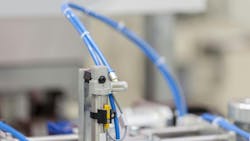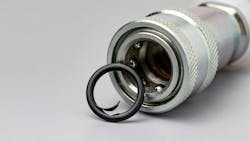NFPA Identifies Top Research Priorities for Industrial Fluid Power Systems
The National Fluid Power Association (NFPA) is in the process of creating its newest Technology Roadmap focused on industrial applications (read sidebar below for more information). As part of this process, the association recently outlined the pre-competitive research and development areas the fluid power industry should consider undertaking to ensure hydraulics and pneumatics continue to meet the performance requirements of industrial applications.
To determine these research areas, NFPA conducted two surveys — one focused on hydraulic research areas and the other on pneumatic ones. The association’s Industrial Technology Task Force then met to review the survey results and identify the top research areas as well as research targets to include in the new roadmap document.
Top Research Areas for Hydraulics and Pneumatics
NFPA’s Industrial Technology Task Force has identified eight research areas which the association describes as the broad areas of pre-competitive investigation that could assist in bringing about the capability improvements — ways fluid power technology can improve to remain a technology of choice — previously identified by the task force.
In addition, the task force determined the top research targets for each research area. These targets are described by the NFPA as the objectives that quantify or otherwise describe successful strategies for pursuing the research areas.
Per the NFPA, those working in the hydraulics and pneumatics sector wanting to pursue research of importance to the industry should focus on projects related to these research areas and targets. Doing so will help ensure fluid power components and systems remain a technology of choice in industrial applications.
1. Components - Develop new fluid power components.
Prioritized research targets:
- Control
- Energy Efficiency
- Noise
- Power Density
- Reliability and Durability
Watch our video interview below with Jon Jensen, CFPPS, CFPECS & CFPAI, Industry Projects Manager - Energy, SMC Corporation of America (no relation to author), to learn more about creation of efficient pneumatic systems.
2. Controllability - Improve the controllability of fluid power systems.
Prioritized research targets:
- Data
- Control
- Energy Efficiency
- Noise
- Safety
3. Data and Analytics - Improve the gathering and use of data analytics in fluid power systems.
Prioritized research targets:
- Data
- Control
- Service
4. Fluids - Optimize the use of fluids and lubrication in fluid power systems.
Prioritized research target:
- Environmental Impact
5. Materials - Develop/apply new materials in fluid power components and systems.
Prioritized research targets:
- Power Density
- Reliability and Durability
6. Seal Technologies - Optimize the use of seal technologies in fluid power systems.
Prioritized research targets:
- Environmental Impact
- Reliability and Durability
7. Sensor Technologies - Advance sensor technologies used in fluid power systems.
Prioritized research targets:
- Data
- Control
- Energy Efficiency
- Reliability and Durability
- Safety
- Service
8. System Architectures - Explore novel fluid power system architectures.
Prioritized research targets:
- Energy Efficiency
- Environmental Impact
- Noise
- Power Density
- Safety
Download the NFPA’s report on the research areas and targets for more insights from the surveys conducted as well as details on the chosen research priorities identified by the association’s task force.
NFPA Technology Roadmaps Identify Development Strategies for Fluid Power
Every other year the National Fluid Power Association (NFPA) publishes a new Technology Roadmap. The goal of these roadmaps is to provide the fluid power industry with a document outlining technology strategies for hydraulics and pneumatics. Doing so provides the fluid power industry with insight on technological requirements for various customer markets so it can better focus development efforts to meet these needs.
Previous editions of the roadmap have been focused more on mobile applications, prompting the NFPA to create a roadmap specifically for the industrial sector — which includes applications such as machine tools, packaging machinery, and power generation.
The association is nearing the final stages of the roadmap creation process and anticipates publishing the 2025 Industrial Technology Roadmap in November. In addition to determining key research areas as part of this process, the association and its members have also identified the customer drivers and strategies as well as capability improvements most important to industrial fluid power applications. You can read more about these in the articles linked below:
Uptime and Automation Among Key Design Objectives for Industrial Machinery
9 Ways Fluid Power Tech Needs to Improve for Industrial Applications
About the Author
Sara Jensen
Executive Editor, Power & Motion
Sara Jensen is executive editor of Power & Motion, directing expanded coverage into the modern fluid power space, as well as mechatronic and smart technologies. She has over 15 years of publishing experience. Prior to Power & Motion she spent 11 years with a trade publication for engineers of heavy-duty equipment, the last 3 of which were as the editor and brand lead. Over the course of her time in the B2B industry, Sara has gained an extensive knowledge of various heavy-duty equipment industries — including construction, agriculture, mining and on-road trucks —along with the systems and market trends which impact them such as fluid power and electronic motion control technologies.
You can follow Sara and Power & Motion via the following social media handles:
X (formerly Twitter): @TechnlgyEditor and @PowerMotionTech
LinkedIn: @SaraJensen and @Power&Motion
Facebook: @PowerMotionTech

Leaders relevant to this article:


